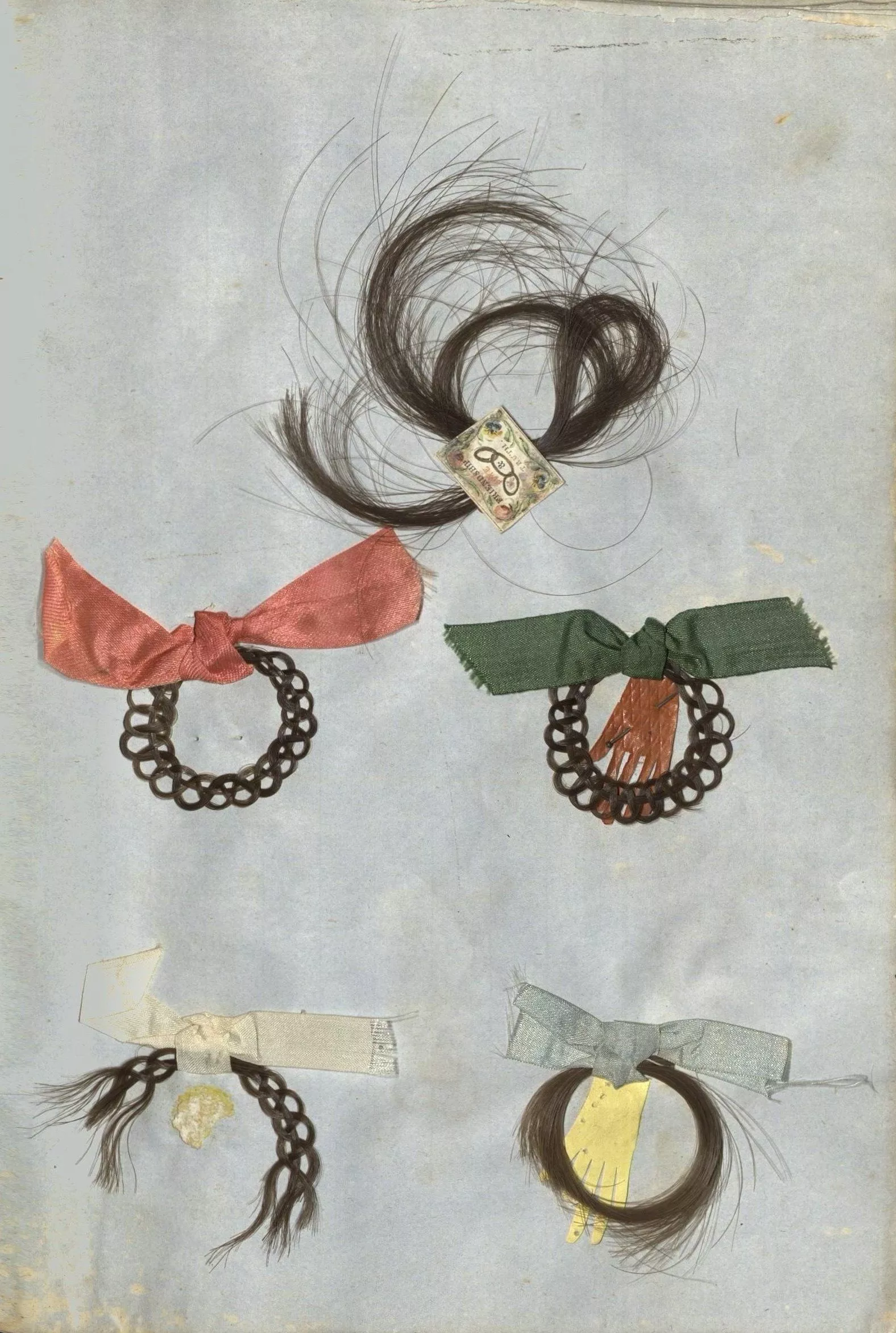Creation Date
1840s
Height
20 cm
Width
13 cm
Medium
Genre
Description
Five wreaths of human hair have been looped through ribbons of various colors, which have in turn been stitched onto a page in a handmade booklet. The booklet, crafted out of sheets of light blue paper which were folded up and stitched together, now contains thirty-eight specimens of hair. But on pages that at first glance look blank, one can see indications (stray threads of ribbon, still attached to the pages, but now untied) that it formerly contained an even greater number of these mementoes.
On this page, three of the locks of hair, those attached to the page with green, pink, and white ribbons, have been intricately plaited. A metal pin, threaded through the page, has been used to attach a small red paper glove to the green ribbon, and the pin holes still visible in the part of the page holding the pink ribbon suggest that this plaited lock originally had a similar ornament. The plaiting of the third lock of hair, the one placed on the bottom left-hand corner of the page and looped through a white ribbon, has begun to come undone.
The fourth and fifth locks of hair found on this page were probably left unplaited from the start. One, placed on the bottom right-hand corner of the page and looped through a blue ribbon, comes with a small yellow paper glove. The lock at the top of the page has been fastened to the page by means a small paper wafer (an object that perhaps would normally have been used to seal a letter). It bears the emblem of the Independent Order of Odd Fellows: three rings linked together, along with the society’s motto, “FRIENDSHIP LOVE & TRUTH.” This slip of paper is embellished with tiny pink and blue flowers with green stems.
The album is entirely lacking in text, so there are no clues now as to the identities either of its compiler or of the individuals whose hair it collects. It may be that the ribbons and gloves originally served as the color-coded labels that identified the locks of hair as belonging to specific women. The slip of paper with the emblem of the Odd Fellows was perhaps included on the page because its text seemed to the album’s compiler an apt declaration of sentiment, or because the linked rings that it pictures bear a resemblance to loops of hair. It is unlikely that the owner of the album would have actually been a member of this fraternal order.
Nineteenth-century lovers and nineteenth-century schoolgirls (not mutually exclusive categories, in fact) alike valued the gift of a lock of hair as an especially intimate token of affection. Such a keepsake is now seen as rather morbid, but was then deemed all the more precious precisely because it was literally a piece of the giver’s body. Nineteenth-century jewelry on both sides of the Atlantic often featured intricate hairwork. Plaited hair was used to form men’s and women’s watch chains, for instance. Or a lover might commission a jeweler to slide a lock of a beloved’s hair under the glass of a ring, as, in Jane Austen’s Sense and Sensibility, the character Edward Ferrars apparently has. Because of the durability of human hair, hairwork was deemed especially suitable for mourning jewelry; to wear such jewelry about one’s person gave the mourner a way to preserve continuing physical contact with the mourned. It is somewhat difficult, however, to see this album as the product of such sincere desires for a prolonged intimacy. There is an impersonality here to the way that the locks of hair have been collected in a group and left unlabeled and indistinguishable from one another. It feels as though the compiler of the album were intent on accumulating as many of these mementoes as possible: the album says more about the quantity than the quality of the friendships. Austen in Sense and Sensibility in fact plays with the way that the lock of hair can be a disappointingly impersonal keepsake, at the same time that she also registers early-nineteenth-century anxieties that jewelers sometimes carelessly, in the press of business, substituted one lock with another which it only resembled. The hair inside Edward Ferrars’s ring is identified variously at different moments in the novel and ascribed to three different women altogether.
Later in the nineteenth century, a favorite domestic handicraft for women involved fashioning wreathed hair to make it simulate flowers, leaves, and twigs. This album suggests that one might draw a connection between the preservation between a book’s pages of pressed flowers and the preservation in the same medium of locks of hair. In both cases, a piece of organic material is removed from its original setting (whether from the body of a particular friend or from a particular natural setting). It is preserved as a memento of itself.
Collection
Accession Number
A/H1535
Additional Information
Materials: Handmade paper and inserted hair work.

